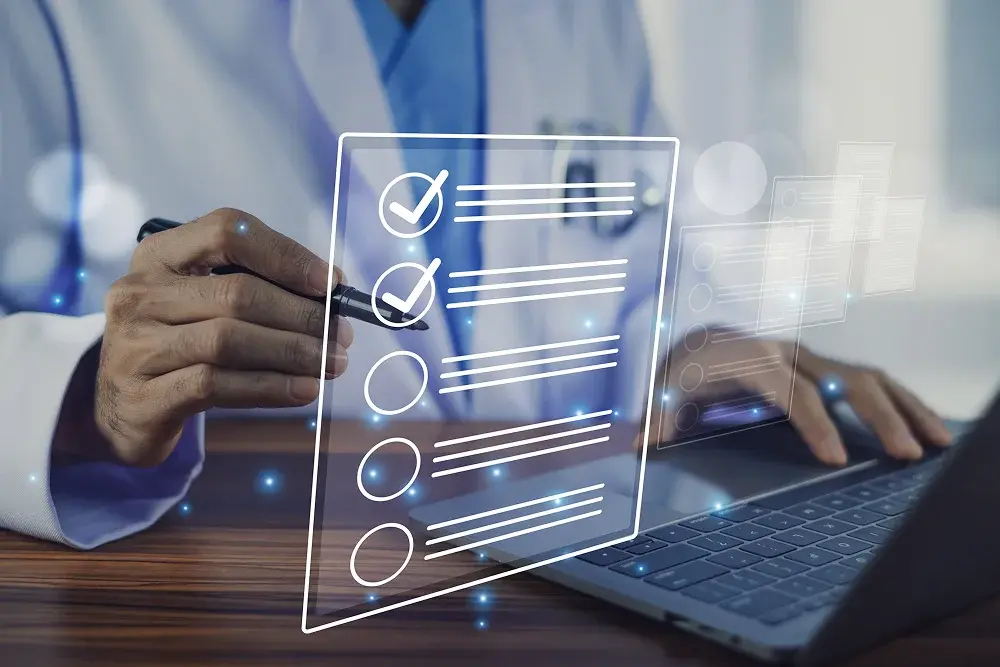Effective use of an EHR dashboard can boost your practice efficiency by up to 40%. While forward-thinking practices have already begun adopting single-point dashboards, many still limit their use to surface-level...
The Merit-based Incentive Payment System (MIPS) is a reimbursement program that rewards high-value and high-quality healthcare performance with pay increases and monetary incentives. Designed to drive improvement in care processes and health outcomes, MIPS’ core goal is to support a healthier population.
Despite its potential, MIPS poses some serious challenges, the biggest of which is reporting. In a qualitative study, some healthcare providers reported that MIPS reporting can impose a financial burden on their healthcare practice, with annual costs ranging from $30,000 to $50,000. The major challenge associated with MIPS reporting is the administrative burden and costs, which require automation. In this blog, we discuss everything about MIPS reporting, from its challenges to the best solutions to improve your MIPS reporting.
Are You Eligible for MIPS?
To confirm your eligibility for MIPS, assessing yourself based on the MIPS eligibility criteria is essential. The first step to achieving optimal MIPS reporting is to align with the eligibility criteria for the Merit-based Incentive Payment System (MIPS).
Eligibility status is specific to each practice that you are associated with and is based on the following factors:
- Clinician type – You must be an MIPS-eligible clinician type on Medicare Part B claims.
- Enrolment date – You must have enrolled as a Medicare provider before 2023.
- APM Status – You must not be a Qualifying Alternative Payment Model Participant.
- Threshold – You must exceed the low-volume threshold:
-
- Bill more than $90,000 for Part B services covered by Medicare
- See more than 200 Part B patients
- Provide 200 or more covered professional services to Part B patients
If your practice is eligible for MIPS, you are required to report activity and measure data for performance throughout the performance year.
Who is Exempted from MIPS Reporting?
Though there are criteria for exemptions, these are subject to change and may not be available for 2023 filing. Unless exempt from MIPS reporting, penalties are in place for non-participation. These penalties can be as significant as 9% of Medicare revenue for not participating and not earning sufficient points to make it to the bonus pool.
Having a reporting plan in place is crucial to meeting the comprehensive reporting criteria and maximizing payment adjustments. However, you are exempted from MIPS if you are not one of the clinician types listed below:
-
-
- Chiropractors
- Clinical nurse specialists
- Clinical psychologists
- Clinical social workers
- Certified nurse midwives
- Certified registered nurse anesthetists
- Dental medicine practitioners
- Dental surgery practitioners
- Doctor of medicine practitioners
- Doctor of osteopathy practitioners
- Nurse practitioners
- Occupational therapists
- Optometry practitioners
- Osteopathic practitioners
- Physical therapists
- Physician assistants
- Podiatric medicine practitioners
- Qualified audiologists
- Qualified speech-language pathologists
- Registered dietitians or nutrition professionals
-
Registry Reporting vs eQCM Reporting
When it comes to MIPS reporting, there are two main ways to track and report, i.e., with a registry or eQCM.
- Registry Reporting
Registry reporting is a long-standing, traditional reporting method. Despite newer and more efficient models currently in practice, registry reporting has its benefits. These include:
-
- Comprehensive flowsheets to track trends and plan ahead
- Detailed dashboard to monitor data and track progress
One disadvantage of registry reporting is its inability to stand alone without a supporting documentation system. Registry reporting requires a tedious amount of admin that wastes a practice’s valuable time, energy, and resources. However, a significant disadvantage of registry reporting is that the points earned for a specific quality measure are lower when reported through a registry in comparison to an eCQM reporting method.
- eCQM Reporting
Electronic Clinical Quality Measures (eCQMs) reporting systems work alongside electronic health records (EHRs) to increase access to real-time information. Working in real-time with automated processes and systems, eCQMs have the advantage of reducing the need for additional IT resources and administrative support for MIPS reporting. This means:
-
- Reduced time and energy spent on the turnkey submission process
- Maximized financial reimbursement by earning the most MIPS points
While eCQM reporting does rely on clinical data extracted from the medical record, it is vital that the clinical record be organized, and the tool(s) used for extraction is designed to scrub elements against countless combinations of available measures. eCQM reporting also necessitates an efficient and secure EHR system, like Practice EHR, for patient data accuracy. Furthermore, the integration between the EHR and the extraction software must be seamless, with constant feedback to the providers.
MIPS Reporting
In order to participate in the Merit-based Incentive Payment System (MIPS) program, MIPS-eligible clinicians are required to report data for their evaluation. There are three reporting options for MIPS.
- Traditional MIPS
Traditional MIPS reporting is the original reporting framework and can be used to select quality measures and improvement activities to collect data for and report on. It's essentially the original way healthcare providers could report their performance for MIPS.
Here's how it works: You get to pick and choose which quality measures and improvement activities you want to report from an extensive list of options approved for MIPS. No one-size-fits-all here! In addition to that, you're also required to report all the measures in the Promoting Interoperability category.
- APM Performance Pathways
The APM Performance Pathway, short for the Alternative Payment Model Pathway, is a newer, more streamlined reporting framework that aims to simplify reporting by creating new scoring opportunities. Here's how it works: If you're in an MIPS APM, you'll report a specific set of measures chosen for you. This set includes quality measures and the complete set of Promoting Interoperability measures (the same as those reported in traditional MIPS).
One perk for MIPS APM participants is that they automatically receive full credit in the improvement activities performance category, although this is assessed annually. This helps reduce the reporting workload and allows professionals in APMs to focus on delivering quality care rather than getting bogged down by administrative tasks.
- MIPS Value Pathways
MIPS Value Pathways, also known as MVPs, offer a subset of measures and activities that are more relevant to specialties, medical conditions, or episodes of care, making them more meaningful to specialized services. With MVPs, you get a handpicked selection of measures and activities particularly relevant to your specialty or the medical condition you're dealing with. This way, you're not drowning in a sea of measures that may not be as pertinent to your practice. It's like getting a custom-made assessment toolkit.
Starting from the 2023 performance year, you'll have to deal with fewer quality measures and improvement activities than the traditional MIPS reporting method. However, you'll still report the complete set of Promoting Interoperability measures (the same ones you'd report under the traditional MIPS approach).
The Challenges Associated with MIPS Reporting
Like any program, MIPS has some challenges associated with it. These include:
- Lack of Focus on Better Patient Outcomes
MIPS is criticized for its lack of focus on better patient outcomes because MIPS mostly looks at how healthcare processes are carried out rather than focusing on the final results for patients. However, MIPS is taking active measures to address patient concerns by refining and updating the system for better patient outcomes.
- Administrative Burden of Reporting
MIPS has comprehensive reporting frameworks that can exhaust a significant amount of time and effort, thereby taking away the attention from care delivery. With penalties in place for poor performance and non-participation, it’s crucial that all reporting is done correctly, accurately, and on time. This is incredibly challenging for small practices with limited resources.
How to Improve MIPS Reporting?
Despite the challenges posed by MIPS reporting, there are ways to mitigate these challenges and streamline the process. These include:
- Determining Eligibility Early
With extensive reporting frameworks and significant penalties in place for non-participation, determining eligibility early is a vital part of the process. Pre-outlining your benchmarks and specifications helps you to select target measures early on and start recording your best-performing measures to guarantee maximum payment adjustments.
You can determine eligibility and ensure compliance by:
-
- Checking if you’re participating as an individual group, virtual group, and/or APM entity.
- Confirm which reporting framework you’ll follow to collect and submit data.
- Establishing if you qualify for reporting factors that may impact your reporting requirements.
- Review the current performance year’s quality measures and determine which collection types (eCQMs, claims measures, etc.) align with your reporting requirements.
- Staying up to date with your eligibility status to assist in planning your reporting requirements.
- Integrating EHR into Your Practice
EHRs that can trigger Electronic Clinical Quality Measures (eCQMs) have increased benefits, making it easier to measure and track the quality of healthcare services. Integrating an electronic health record (EHR) system into your healthcare practice becomes an essential requirement that cannot be overlooked. Built into EHR systems, eCQMs are simple and easy to use and help practices across the US simplify MIPS reporting. With structured fields for reporting, eCQMs minimize the need for manual data entry while maximizing the total number of MIPS points.
With automated processes, eCQMs help to ensure healthcare providers deliver effective, safe, and efficient patient care without missing out on valuable MIPS points. A reliable and robust EHR system, like Practice EHR, alleviates the administrative burden associated with MIPS reporting and helps clinicians focus on patient care instead.
Practice EHR - ONE Solution to Your MIPS Reporting Issues!
MIPS reporting has become necessary for MIPS-eligible clinicians, and mitigating the challenges and issues associated with the process must be addressed. One of the major issues with MIPS reporting is the associated administrative burden, which can be automated with an efficient electronic health record (EHR) system.
Practice EHR is The One partner you need to simplify and improve the MIPS reporting process. With our comprehensive cloud-based systems, you’ll streamline the complex reporting process to eliminate the worry of penalties and maximize time spent on care delivery.
Schedule A Free Demo and take your first step toward stress-free, accurate, and seamless MIPS reporting today!
Topics: Integrated EHR, Small Practice, EHR Solution, New Technology, EMR, EHR, MIPS, Reporting Under MIPS, MIPS Reporting
RECENT POSTS



TOPICS
- EHR Solution (192)
- EHR (127)
- digital age (119)
- Patient Care (117)
- Medical Billing (112)
- Specialty-Specific EHR (112)
- Industry Update (98)
- Technology in Healthcare (84)
- EHR Features (79)
- Small Practice (78)
- Medical billing services (74)
- Integrated EHR (63)
- RCM (63)
- HIPAA Security (62)
- New Technology (44)
- Cloud-based EHR (43)
- Telemedicine (43)
- Healthcare Office Management (40)
- Practice EHR News (38)
- Kiosk (31)
- Revenue Cycle Management (28)
- AI Solutions (25)
- ePrescribing (21)
- AI Scribing (17)
- Best EHR Software (17)
- Practice Management Software (13)
- AI-powered Medical Billing (12)
- EMR (12)
- AI EHR (11)
- Practice Automation (11)
- TeleVisit (11)
- Client Favorites (10)
- The ONE (10)
- AI Scribe (9)
- Switching to New EHR (9)
- Best EHR Practice (8)
- EHR Integration (8)
- MACRA/MIPS (8)
- Patient Portal (8)
- Psychiatry EHR (8)
- Urgent Care (8)
- AI scanning (7)
- Automated Health Tools (6)
- E-Prescribing (6)
- Medical Practice Management Software (6)
- Product Updates (6)
- events (6)
- MIPS (5)
- Mobile EHR (5)
- Family Medicine EHR (4)
- HIPAA (4)
- Insider (4)
- Integrated Practice Management (4)
- Internal Medicine EHR (4)
- MIPS Reporting (4)
- Multilingual AI Scribe (4)
- Orthopedics EHR (4)
- Podiatry (4)
- Podiatry EHR (4)
- Regulatory Updates (4)
- Telehealth Platform (4)
- Telehealth Platforms (4)
- Chiropractic EHR (3)
- Digital Experiences (3)
- EHR Flaws (3)
- EHR Implementation (3)
- EHR for Chiropractors (3)
- EHR for Small Practices (3)
- Eligibility Verification in Medical Billing (3)
- Medical Coding Services (3)
- Patient Check-in Kiosk (3)
- PracticeEHR GO App (3)
- Automated EHR (2)
- Cash Flow (2)
- Cashless Payments (2)
- Clearinghouse (2)
- Dermatology EHR (2)
- EHR Scheduling (2)
- Family Medicine (2)
- Foot and Ankle Care (2)
- Foot and Ankle EHR (2)
- Health records 101 (2)
- Healthcare Compliance Certification (2)
- Medical Billing Partner (2)
- Medical Credentialing (2)
- Pediatrics EHR (2)
- Quality of Patient Care (2)
- Reporting Under MIPS (2)
- Risk and Liability in Medical Settings (2)
- Voice-Activated AI Scribe (2)
- What Works Clearinghouse (2)
- ACA Subsidy (1)
- AI Scan (1)
- AI Scribe for Pediatric Care (1)
- Bariatric EHR (1)
- Behavioral Health Practices (1)
- Billing Communication (1)
- Billing for Private Practices (1)
- Cardiology EHR (1)
- Charting (1)
- Data Security (1)
- Dos and Don'ts (1)
- EHR Dashboard (1)
- EHR Guides (1)
- EHR KPIs (1)
- EHR Questions to Ask (1)
- EHR Transition (1)
- EHR for Chronic Illness (1)
- EMR vs EHR Difference (1)
- ENT EHR (1)
- Endocrinology EHR (1)
- Gastroenterology (1)
- Gastroenterology EHR (1)
- General Surgery EHR (1)
- Geriatric AI scribe (1)
- Geriatrics EHR (1)
- Guides (1)
- Healthcare Practice Office Management (1)
- Help Center Videos (1)
- Insurance Reimbursement (1)
- KPI (1)
- Key Performance Indicators (1)
- Lab Processing (1)
- MACRA (1)
- Nephrology EHR (1)
- Neurology EHR (1)
- Pain Management EHR (1)
- Patient Behavior (1)
- Pediatric Care (1)
- Physical Therapy EHR (1)
- Practice Cash Flow (1)
- Practice Efficiency (1)
- Pulmonology EHR (1)
- Reconsider Your EHR (1)
- Simplify Practice Management (1)
- Staffing in Healthcare (1)
- Switch Medical Billing Providers (1)
- Urgent Care Medical Billing (1)
- Urology EHR (1)
- insurance claim denials (1)








